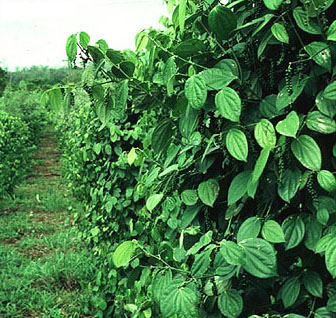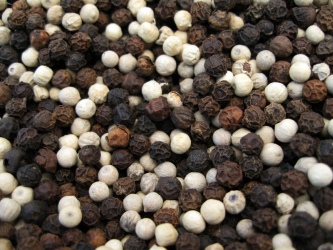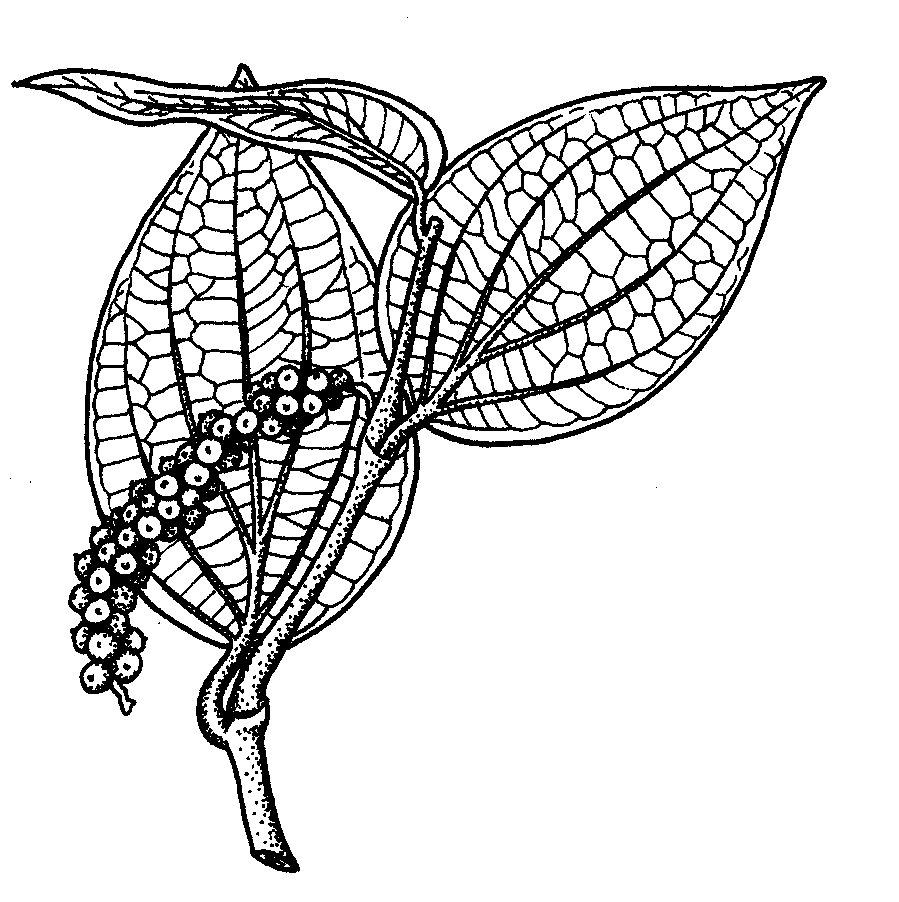 Piper nigrum.
胡
椒 Hú jiāo
Pepper- Black and White
Family: Piperaceae
Piper nigrum.
胡
椒 Hú jiāo
Pepper- Black and White
Family: Piperaceae


Analgesic and anti-inflammatory activities of Piper nigrum L.
Tasleem F, Azhar I, Ali SN, Perveen S, Mahmood ZA.
Abstract
OBJECTIVE:
To evaluate and compare the analgesic and anti-inflammatory activity of pure
compound, piperine along with hexane and ethanol extracts of Piper nigrum L.
fruit in mice and rats.
METHODS:
The analgesic activity was determined by tail immersion method, analgesy-meter,
hot plate and acetic acid induced writhing test. While the anti-inflammatory
activity was evaluated by carrageenan-induced paw inflammation in rats.
RESULTS:
Piperine at a dose of 5 mg/kg and ethanol extract at a dose of 15 mg/kg after
120 min and hexane extract at a dose of 10 mg/kg after 60 min exhibited significant
(P<0.05) analgesic activity by tail immersion method, in comparison to ethanol
extract at a dose of 10 mg/kg using analgesy-meter in rats. However, with hotplate
method, piperine produced significant (P<0.05) analgesic activity at lower
doses (5 and 10 mg/kg) after 120 min. A similar analgesic activity was noted
with hexane extract at 15 mg/kg. However, in writhing test, ethanol extract
significantly (P<0.05) stopped the number of writhes at a dose of 15 mg/kg,
while piperine at a dose of 10 mg/kg completely terminated the writhes in mice.
In the evaluation of anti-inflammatory effect using plethysmometer, piperine
at doses of 10 and 15 mg/kg started producing anti-inflammatory effect after
30 min, which lasted till 60 min, whereas hexane and ethanol extracts also produced
a similar activity at a slightly low dose (10 mg/kg) but lasted for 120 min.
CONCLUSIONS:
It is concluded from the present study that Piper nigrum L possesses potent
analgesic and anti-inflammatory activities.
Copyright © 2014 Hainan Medical College. Published by Elsevier B.V. All rights
reserved. Asian Pac J Trop Med. 2014 Sep;7S1:S461-8. doi: 10.1016/S1995-7645(14)60275-3.
ncbi.nlm.nih.gov
Inhibitory effects of black pepper (Piper nigrum) extracts and compounds
on human tumor cell proliferation, cyclooxygenase enzymes, lipid peroxidation
and nuclear transcription factor-kappa-B.
Liu Y, Yadev VR, Aggarwal BB, Nair MG.
Abstract
Black pepper (Piper nigrum) and hot pepper (Capsicum spp.) are widely used in
traditional medicines. Although hot Capsicum spp. extracts and its active principles,
capsaicinoids, have been linked with anticancer and anti-inflammatory activities,
whether black pepper and its active principle exhibit similar activities is
not known. In this study, we have evaluated the antioxidant, anti-inflammatory
and anticancer activities of extracts and compounds from black pepper by using
proinflammatory transcription factor NF-kappaB, COX-1 and -2 enzymes, human
tumor cell proliferation and lipid peroxidation (LPO). The capsaicinoids, the
alkylamides, isolated from the hot pepper Scotch Bonnet were also used to compare
the bioactivities of alkylamides and piperine from black pepper. All compounds
derived from black pepper suppressed TNF-induced NF-kappaB activation, but alkyl
amides, compound 4 from black pepper and 5 from hot pepper, were most effective.
The human cancer cell proliferation inhibitory activities of piperine and alklyl
amides in Capsicum and black pepper were dose dependant. The inhibitory concentrations
50% (IC50) of the alklylamides were in the range 13-200 microg/mL. The extracts
of black pepper at 200 microg/mL and its compounds at 25 microg/mL inhibited
LPO by 45-85%, COX enzymes by 31-80% and cancer cells proliferation by 3.5-86.8%.
Overall, these results suggest that black pepper and its constituents like hot
pepper, exhibit anti-inflammatory, antioxidant and anticancer activities.
PMID: 20839630 Nat Prod Commun. 2010 Aug;5(8):1253-7. ncbi.nlm.nih.gov
Pharmacological basis for the medicinal use of black pepper and piperine
in gastrointestinal disorders.
Mehmood MH, Gilani AH.
Abstract
Dried fruits of Piper nigrum (black pepper) are commonly used in gastrointestinal
disorders. The aim of this study was to rationalize the medicinal use of pepper
and its principal alkaloid, piperine, in constipation and diarrhea using in
vitro and in vivo assays. When tested in isolated guinea pig ileum, the crude
extract of pepper (Pn.Cr) (1–10 mg/mL) and piperine (3–300 µM) caused a concentration-dependent
and atropine-sensitive stimulant effect. In rabbit jejunum, Pn.Cr (0.01–3.0
mg/mL) and piperine (30–1,000 µM) relaxed spontaneous contractions, similar
to loperamide and nifedipine. The relaxant effect of Pn.Cr and piperine was
partially inhibited in the presence of naloxone (1 µM) similar to that of loperamide,
suggesting the naloxone-sensitive effect in addition to the Ca(2+) channel blocking
(CCB)-like activity, which was evident by its relaxant effect on K+ (80 mM)-induced
contractions. The CCB activity was confirmed when pretreatment of the tissue
with Pn.Cr (0.03–0.3 mg/mL) or piperine (10–100 µM) caused a rightward shift
in the concentration–response curves of Ca(2+), similar to loperamide and nifedipine.
In mice, Pn.Cr and piperine exhibited a partially atropine-sensitive laxative
effect at lower doses, whereas at higher doses it caused antisecretory and antidiarrheal
activities that were partially inhibited in mice pretreated with naloxone (1.5
mg/kg), similar to loperamide. This study illustrates the presence of spasmodic
(cholinergic) and antispasmodic (opioid agonist and Ca(2+) antagonist) effects,
thus providing the possible explanation for the medicinal use of pepper and
piperine in gastrointestinal motility disorders.
PMID: 20828313 DOI: 10.1089/jmf.2010.1065 J Med Food. 2010 Oct;13(5):1086-96.
doi: 10.1089/jmf.2010.1065. ncbi.nlm.nih.gov
Antioxidant efficacy of black pepper (Piper nigrum L.) and piperine
in rats with high fat diet induced oxidative stress.
Vijayakumar RS, Surya D, Nalini N.
Abstract
The present study was aimed to explore the effect of black pepper (Piper nigrum
L.) on tissue lipid peroxidation, enzymic and non-enzymic antioxidants in rats
fed a high-fat diet. Thirty male Wistar rats (95-115 g) were divided into 5
groups. They were fed standard pellet diet, high-fat diet (20% coconut oil,
2% cholesterol and 0.125% bile salts), high-fat diet plus black pepper (0.25
g or 0.5 g/kg body weight), high-fat diet plus piperine (0.02 g/kg body weight)
for a period of 10 weeks. Significantly elevated levels of thiobarbituric acid
reactive substances (TBARS), conjugated dienes (CD) and significantly lowered
activities of superoxide dismutase (SOD), catalase (CAT), glutathione peroxidase
(GPx), glutathione-S-transferase (GST) and reduced glutathione (GSH) in the
liver, heart, kidney, intestine and aorta were observed in rats fed the high
fat diet as compared to the control rats. Simultaneous supplementation with
black pepper or piperine lowered TBARS and CD levels and maintained SOD, CAT,
GPx, GST, and GSH levels to near those of control rats. The data indicate that
supplementation with black pepper or the active principle of black pepper, piperine,
can reduce high-fat diet induced oxidative stress to the cells.
PMID: 15231065 DOI: 10.1179/135100004225004742 Redox Rep. 2004;9(2):105-10.
ncbi.nlm.nih.gov